As more SaaS companies shift from traditional subscription models to usage-based pricing, developers need robust billing infrastructure that can handle complex metering, real-time usage tracking, and flexible pricing models. Whether you're billing by API calls, data processed, or active users, choosing the right usage-based billing platform is crucial for scaling your business.
At Knock, we provide product + customer messaging infrastructure that uses a usage-based billing model to charge our customers based on the volume of notifications sent each month.
From early on, we’ve outsourced usage-based billing so we can focus on building our core product. You can visit part 1 or part 2 of our blog series about evaluating and implementing a usage-based billing provider (spoiler: we use Orb).
How to evaluate usage-based billing systems
We evaluated the most popular usage-based billing solutions based on developer experience, pricing flexibility, integration capabilities, and scalability.
- Developer experience. A clean API with comprehensive SDKs and clear documentation reduces implementation time from weeks to days.
- Pricing flexibility. The platform should be able to support various pricing models, from simple per-unit charges to complex tiered structures with volume discounts.
- Integration capabilities. Native connections to your existing tech stack, including payment processors, data warehouses, and accounting systems, eliminate custom middleware development.
- Scalability. The system must handle your growth trajectory, processing millions of usage events without performance degradation or exponential cost increases.
Based on these criteria and their obvious dominance in the billing industry, you may be reading this thinking “can’t you just use Stripe to power this?” You are technically correct and you can use Stripe’s usage-based billing solution, however, in practice there are areas where this falls short:
- Handling per-customer adjustments. Sales negotiations often result in custom contract prices and volume discounts, which, in Stripe, are usually accounted for at the plan level or as discounts applied to a subscription. Both of these approaches have drawbacks: structuring as plans means you'll likely end up creating bespoke plans per customer in Stripe, which can get messy quickly and is difficult to migrate from, and structuring as discounts means your customer's invoices will always include the base prices with discounts shown.
- Supporting different billing providers. Demand for using bill.com as the billing layer becomes a problem when customers are only offered payment via ACH or Credit Card through Stripe. Additionally, an abstraction layer here opens up the potential for integrating other billing providers like cloud marketplaces (AWS, Azure, GCP).
- Having a single source of truth for subscription data. If you do end up supporting multiple billing providers, the source of truth quickly becomes the application database, which means you're likely going to have to do additional work to consolidate this data to understand billing metrics like revenue retention, churn, billing history, ARR, etc.
- Flexibility to model complex product offerings. Stripe has great coverage for lots of different subscription models, but things can get complex quickly when you want to introduce plans that mix multiple models (e.g. seats in addition to usage-based consumption).
Overview
Based on the above criteria, here are the top 5 platforms that developers are using to implement usage-based billing in 2025.
Orb
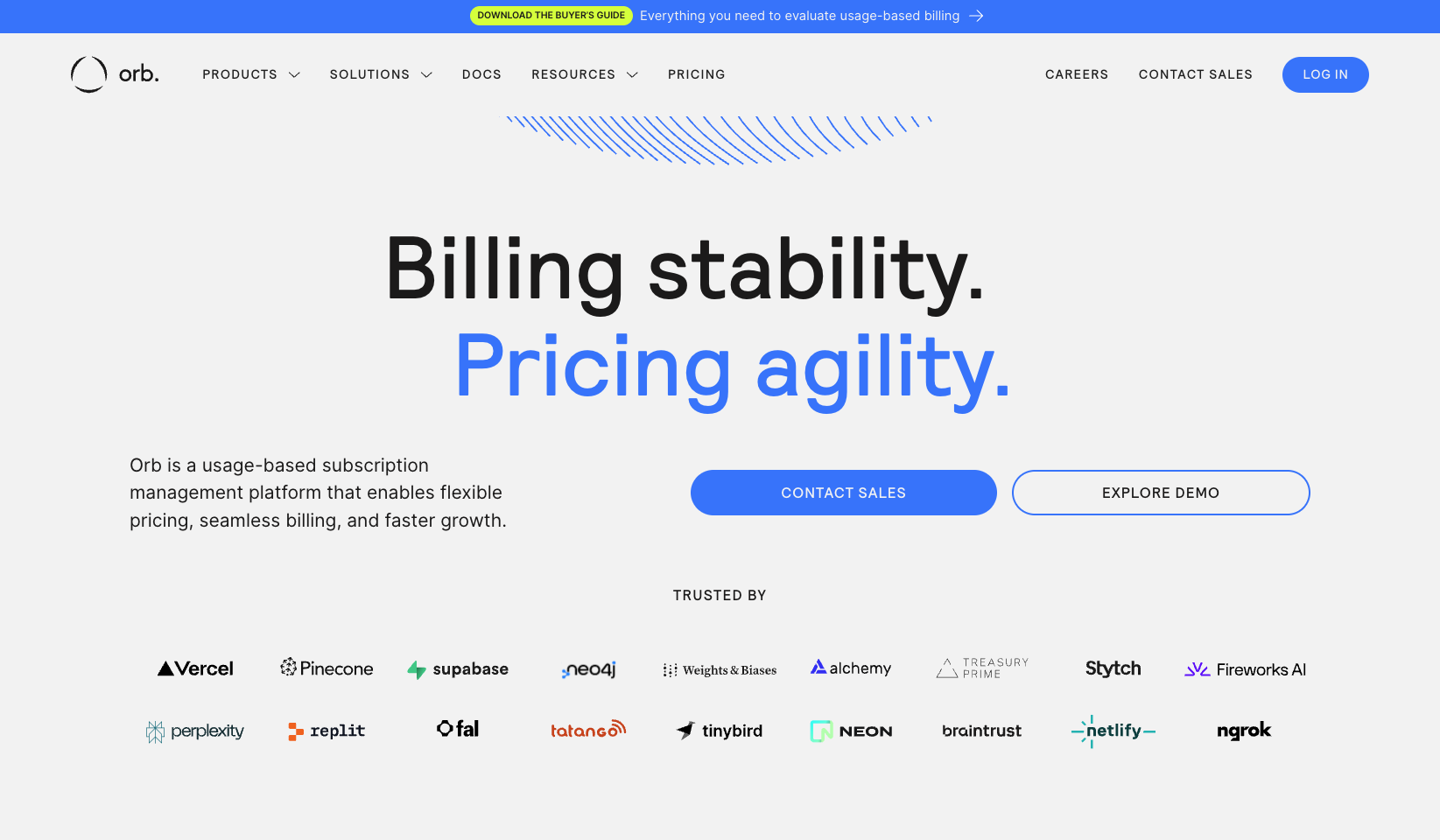
Orb is a developer-first usage-based billing platform that handles complex pricing models with an elegant API design. Built by engineers who previously worked on billing infrastructure at companies like Stripe and Asana, Orb focuses on making usage data ingestion and pricing configuration as simple as possible.
Key features
- Real-time usage ingestion: Stream usage events via API or batch uploads with automatic deduplication
- Flexible pricing models: Support for tiered, volume, and package pricing with per-unit or percentage discounts
- SQL-based metrics: Define custom usage metrics using SQL queries for maximum flexibility
- Audit trail: Complete history of pricing changes and customer amendments
- Developer-friendly SDK: Available for Python, TypeScript, Go, and Ruby
Pricing
Orb offers transparent usage-based pricing starting at $0 for up to 250 invoices per month, then $1 per invoice thereafter. Enterprise plans include custom pricing and SLAs.
To learn more about Orb pricing, head to its pricing page.
Best for
Infrastructure companies, API-first businesses, and teams that need granular control over their usage metrics and pricing models. Particularly strong for companies with complex B2B pricing requirements, like multi-year contract terms, custom enterprise discounts, or usage overage calculations.
Overall, we chose Orb for several reasons. From a usability standpoint, we thought they had the most well-developed UI interface and dashboard. Beyond that, we found their documentation well-written, and their API and primitives well thought through.
Lago
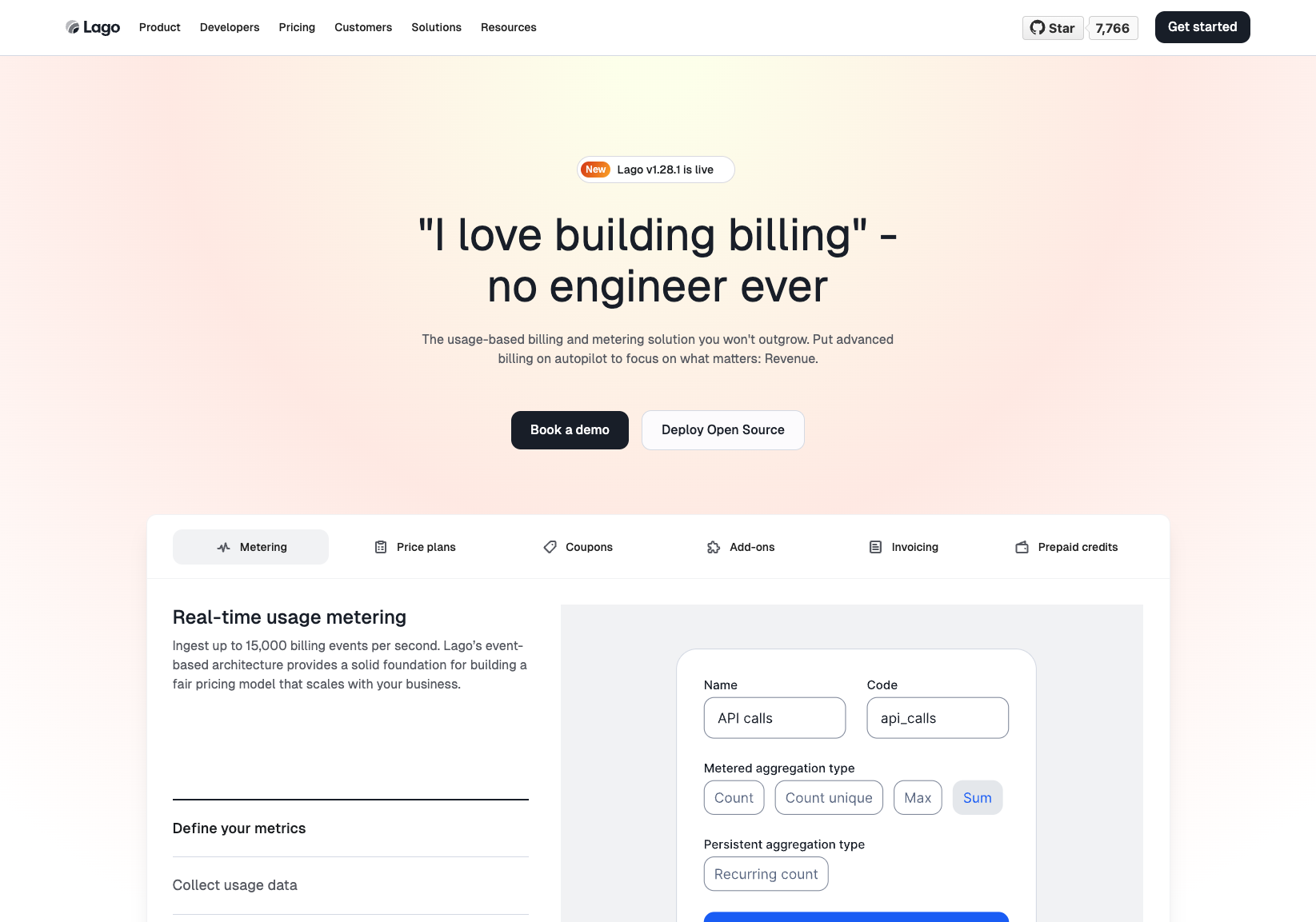
Lago is an open-source usage-based billing platform that gives developers complete control over their billing infrastructure. With both cloud and self-hosted options, Lago provides flexibility for teams with specific compliance or customization requirements.
Key features
- Open-source: Full access to source code with active community development
- Event-based architecture: Real-time event ingestion with automatic aggregation
- Instant charges: Support for one-time fees alongside usage-based billing
- Webhook system: Real-time notifications for billing events
- REST API: Comprehensive API for all billing operations
Pricing
The open-source version is free to self-host. The cloud version starts at $0 for up to 10,000 events per month, then usage-based pricing applies.
To learn more about Lago pricing, head to its pricing page.
Best for
Engineering teams that want full control over their billing stack, companies with specific compliance requirements, and organizations comfortable with self-hosting infrastructure.
Metronome
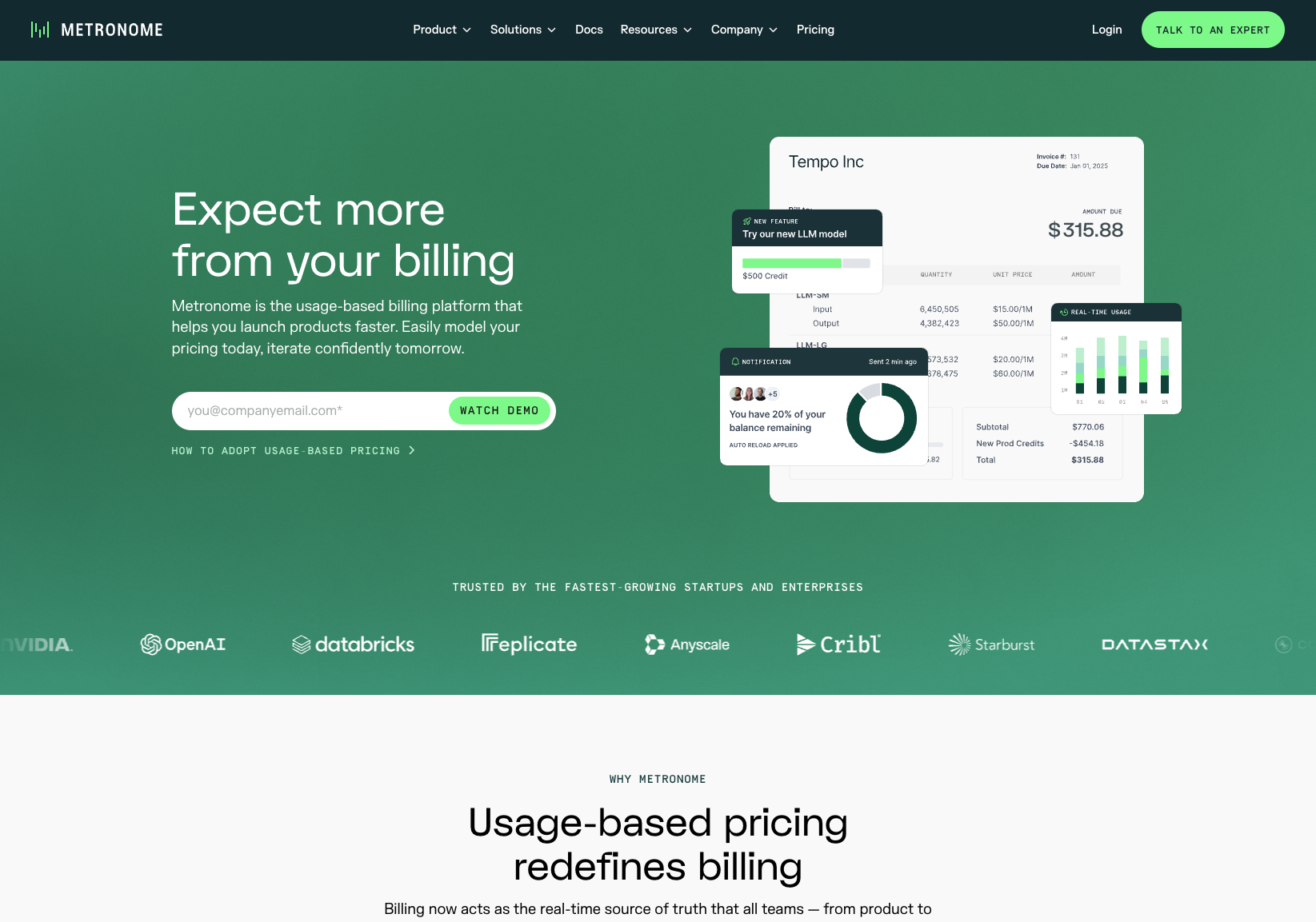
Metronome specializes in usage-based billing for high-volume B2B SaaS companies. Built by former AWS and Dropbox engineers, it's designed to handle billions of usage events while maintaining real-time accuracy.
Key features
- High-throughput ingestion: Process millions of events per second with guaranteed delivery
- Contract management: Built-in support for enterprise contracts and commitments
- Real-time alerts: Configure usage alerts and notifications for customers
- Data warehouse sync: Native integrations with Snowflake, BigQuery, and Redshift
- Revenue recognition: Automated ASC 606 compliance and reporting
Pricing
Custom pricing based on usage volume and features. Typically starts at $1,000+/month for enterprise customers.
To learn more about Metronome pricing, head to its pricing page.
Best for
High-growth SaaS companies, enterprises with complex contract terms, and businesses processing billions of usage events monthly.
Chargebee
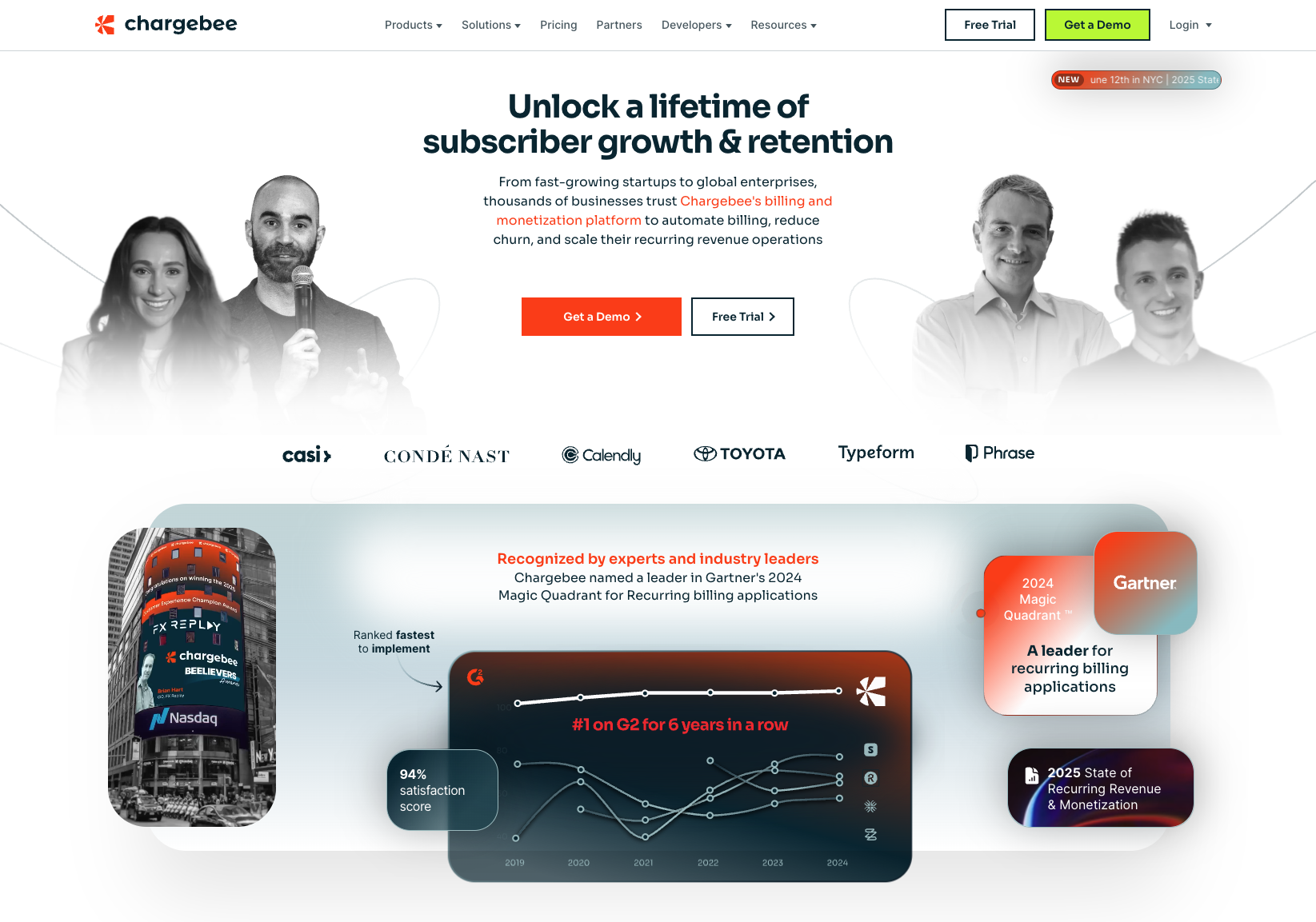
Chargebee is a comprehensive subscription and usage-based billing platform that supports both traditional subscriptions and consumption-based pricing. With extensive third-party integrations, it's popular among mid-market companies.
Key features
- Hybrid billing: Combine subscription and usage-based pricing in a single invoice
- Quote-to-cash: Full CPQ (Configure, Price, Quote) functionality
- Multi-currency support: Bill in 100+ currencies with automatic conversion
- Dunning management: Intelligent retry logic and customer communication
- Extensive integrations: 30+ payment gateways and 50+ third-party apps
Pricing
Starts at $0 for up to $100K in monthly recurring revenue, then tiered pricing from 0.75% to 0.6% of MRR.
To learn more about Chargebee pricing, head to its pricing page.
Best for
Mid-market SaaS companies, businesses with global customers, and teams needing extensive third-party integrations.
Zuora
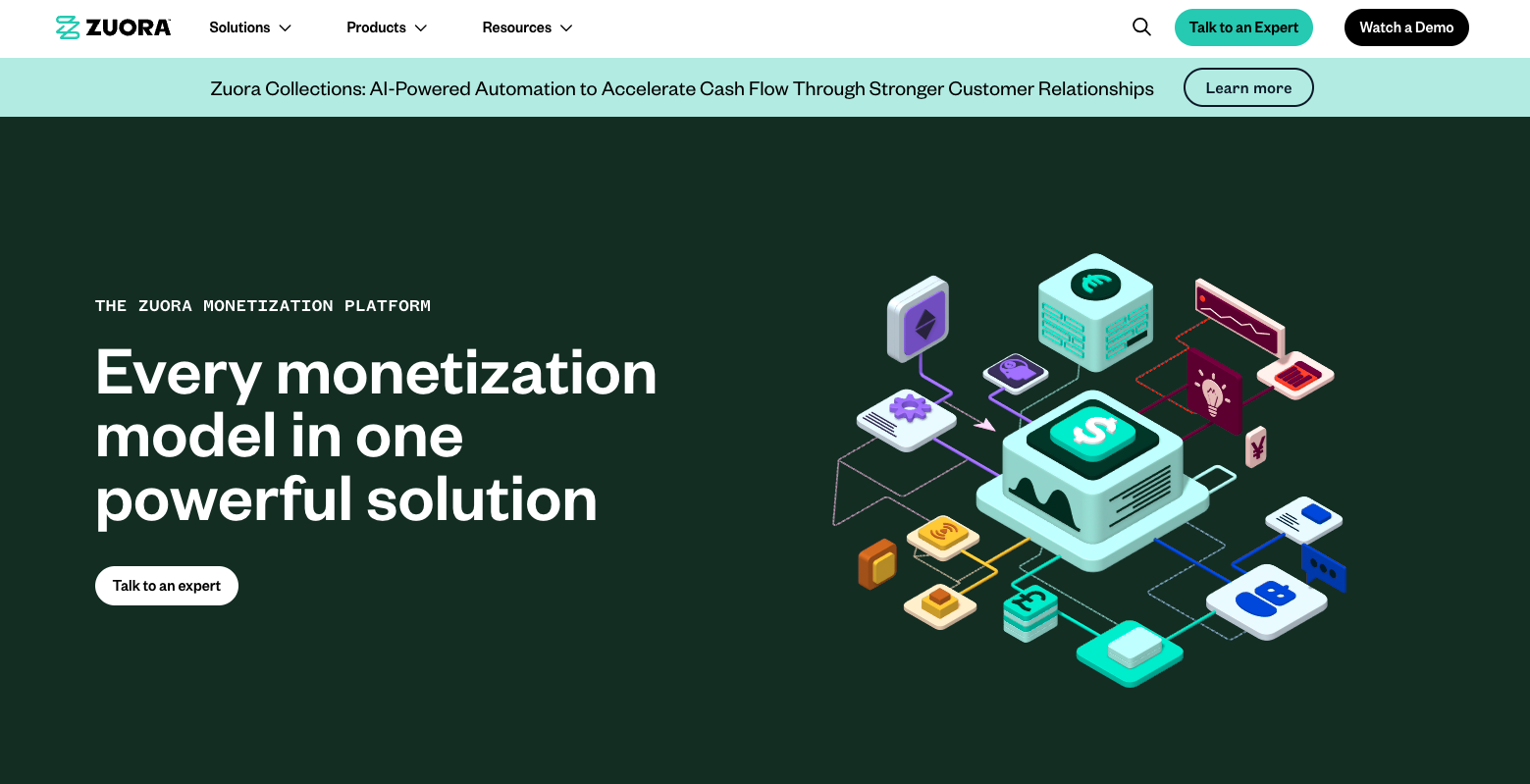
Zuora is an enterprise-grade billing platform that pioneered the subscription economy. While traditionally focused on subscriptions, Zuora has expanded to support complex usage-based and hybrid billing models.
Key features
- Rating engine: Sophisticated usage rating with real-time mediation
- Revenue automation: Complete order-to-revenue workflow automation
- Product catalog: Centralized catalog for all products and pricing
- Multi-entity support: Bill across multiple subsidiaries and entities
- Compliance: SOC 2 Type II, PCI DSS Level 1, and ISO 27001 certified
Pricing
Custom enterprise pricing, typically starting at $25,000+ annually based on billing volume and features.
To learn more about Zuora pricing, head to its pricing page.
Best for
Large enterprises, companies with complex multi-entity structures, and businesses requiring extensive compliance certifications.
Choosing the best billing provider for you
Choosing a usage-based billing provider in 2025 comes down to choosing a platform that matches your current needs but can also adapt as your pricing strategy evolves.
You’ll want to consider all of these factors:
- Integration complexity: How easily does the platform integrate with your existing tech stack?
- Pricing flexibility: Can it handle your current and future pricing models?
- Scale requirements: Will it grow with your usage volume?
- Developer experience: How much engineering effort is required for implementation?
- Total cost: Factor in both platform fees and implementation costs
For most developer teams, starting with a modern platform like Orb or Lago provides the best balance of flexibility and ease of implementation. As you scale, you can evaluate whether a mid-market solution like Chargebee or an enterprise solution like Metronome or Zuora makes sense for your specific needs.
With the right usage-based billing infrastructure in place, you can focus on building great products while your billing system handles the complexity of usage tracking and invoicing.
Using Knock to manage customer billing notifications
You’ll also want to think about a solution that can help you manage customer communication about charges, usage limits, and billing events in a sophisticated way.
Knock enables companies to build notification workflows that automatically route billing alerts through the right channel at the right time—whether that's an email for monthly invoices, an in-app notification for usage approaching limits, or an SMS for payment failures.
In addition to cross-channel support, advanced messaging capabilities become particularly valuable during important, yet sensitive, billing moments. Consider these scenarios:
- Delays. A usage spike might trigger an in-app toast notification for immediate awareness, followed by an email summary if the user doesn't acknowledge it within a certain timeframe.
- Throttling. Rate limiting prevents accidental notification floods during high-usage periods.
- Batching. Intelligent batching consolidates multiple, related usage alerts into digestible summaries, so you can send fewer notifications to your users.
- Preferences. The preference management system gives customers control over how they receive billing updates, including the ability to set billing thresholds directly in their notification settings. This ensures critical payment alerts reach customers while respecting their communication boundaries.
For usage-based applications processing millions of events across their users, this infrastructure transforms what would be a complex engineering challenge into a manageable configuration that scales with your billing volume.
Companies like Vercel leverage Knock to ensure their customers stay informed about their usage and billing status without being overwhelmed by redundant messages. Read Vercel’s case study to learn more.
If you want to improve the way you send billing notifications across multiple channels, Knock can help. If you'd like to try it out, you can sign up for a free account or chat with our team. 👋